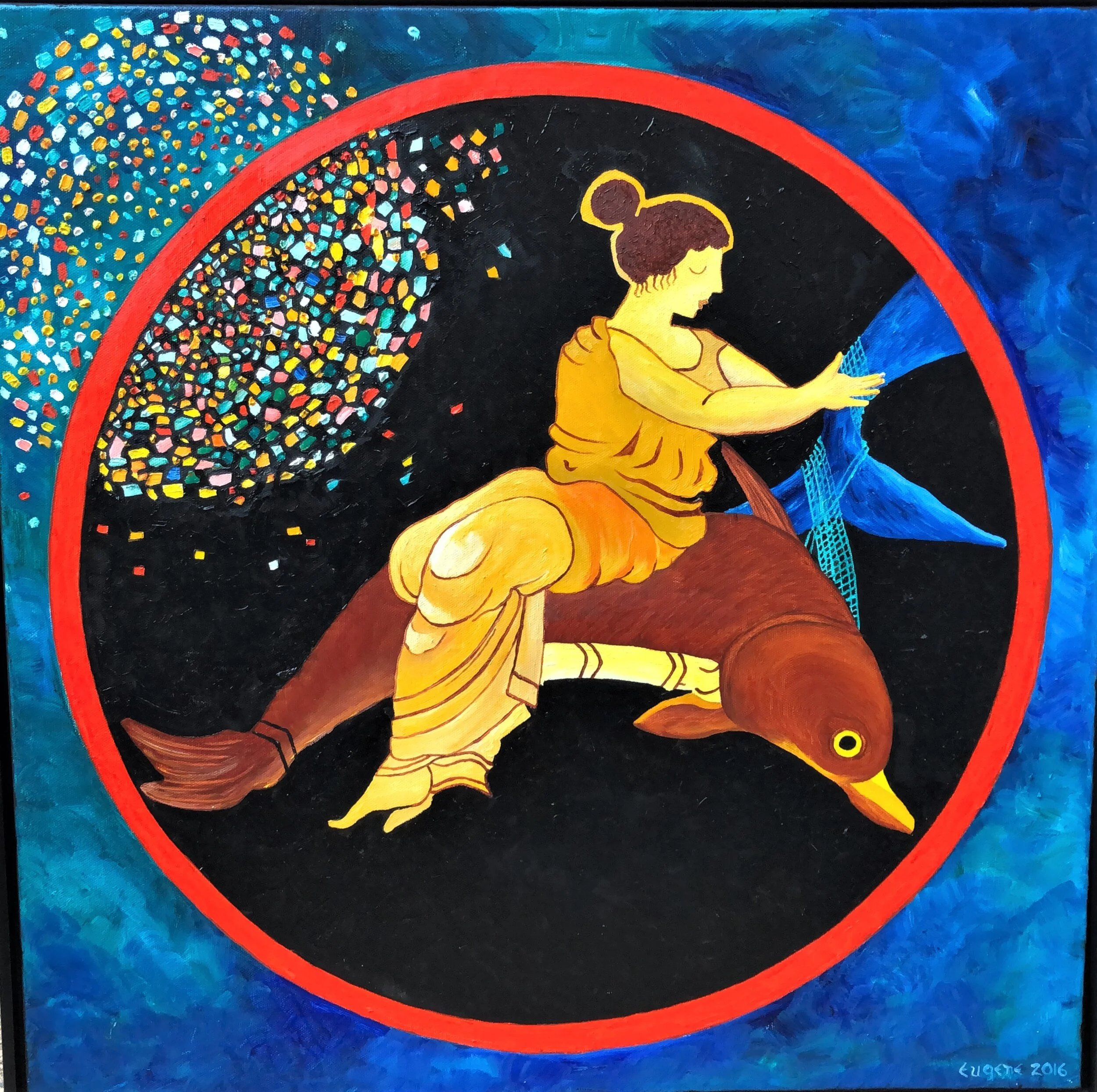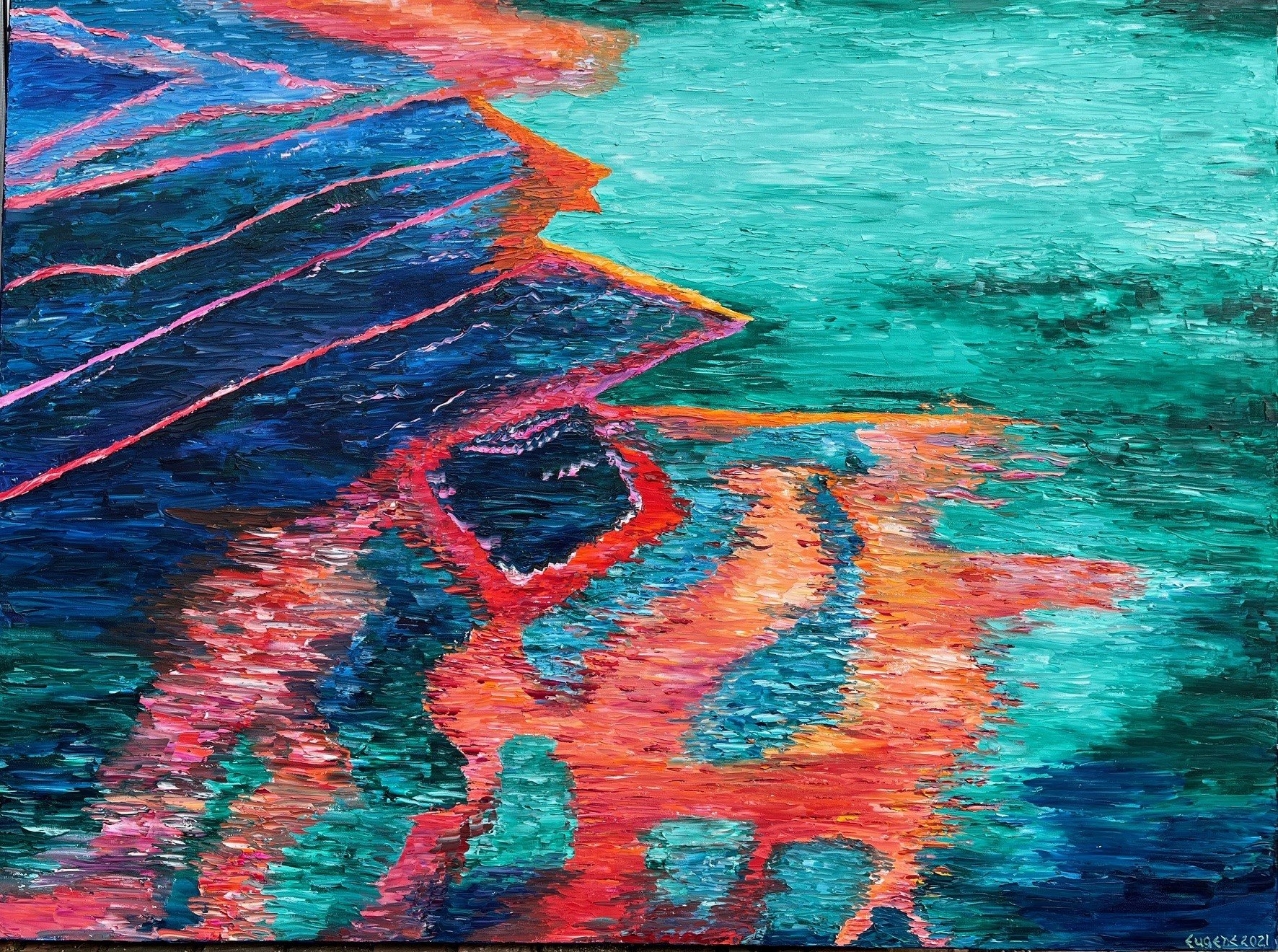












Catalogue Number: EGM-111
Oil on canvas (30x40”)©Eugene G. Maurakis, Ph.D. 2019. Chelonia mydas (Green sea turtle). Plastic fragments account for up to 74% of the diet of sea turtles. In 2018, the journal Nature reported that juvenile green sea turtles ingesting one piece of marine debris plastic experience a 22% chance of death; ingesting 14 pieces increases their chance of death to 50 %.

Plastic Oceans https://www.youtube.com/watch?v=A63I9Miqjh0 highlights the impacts of plastics on marine biodiversity. The animated film, based on a series of 10 oil paintings, focuses attention to the tidal wave of plastics saturating our seas and oceans and their impacts on environmental health and potentially human health. Plastic Oceans features new research indicating that algae, as well as carcinogens (PCBs, DDT, and other pesticides) attach to microplastics. The concentrated odor of algae encrusted on microplastics attracts fishes, which eat the algal-covered microplastics coated with toxic-chemicals. No longer can we contaminate the natural world with plastics because of their convenience, which has promoted our inattention to their harms to marine animals and food webs. Now is the time to act and change our behavior.
We thank University of Richmond for in-kind services, UN Environment Programme, UNESCO, Wilcox et al. 2018, Rochman et al. 2015, Matto, 2001, and Jambeck et al. 2015 for data and assertions, and RVA Environmental Film Festival for the award.

Catalogue Number: EGM-116
Oil on canvas (30x40”)©Eugene G. Maurakis Ph.D. 2019. Sebastes caurinus (Copper rockfish). By 2050, the weight of plastic (937 million tons) will exceed the weight of fishes (895 million tons) in all oceans.

Catalogue Number: EGM-117
Oil on canvas (30x40*)©Eugene G. Maurakis Ph.D. 2019. Oncorhynchus tshawytscha (Chinook Salmon). Without changing our behavior, the amount of plastic in oceans is predicted to increase 20-fold by 2025.

Catalogue Number: EGM-113
Oil on canvas (30x40”)©Eugene G. Maurakis Ph.D. 2019. Pelecanus occidentalis (Brown pelican) – Over a million seabirds succumb to the ingestion of plastics each year. By 2050, 99% of all seabirds will have ingested plastic. Mixed media, oil on canvas and recycled plastics ,

Catalogue Number: EGM-118
Oil on canvas (30x40”)©Eugene G. Maurakis Ph.D. 2019. Scomber japonicus (Pacific mackerel). Every year, about 8 million metric tons (~18 billion pounds) of plastic waste flow into the oceans. That is like dumping a garbage truck-load of plastic into the oceans every minute.

Catalogue Number: EGM-115
Oil on canvas (30x40”)©Eugene G. Maurakis Ph.D. 2019. Engraulis mordax (California anchovy). Algae, as well as potential carcinogens (PCBs, DDT, and other pesticides) adhere to microplastics. Fishes and other organisms smell and eat the algal-covered microplastics coated with toxic-chemicals, which move up the food chain to humans. We do not yet know, however, the full effects of these microplastics coated with toxic chemical on human health.

Catalogue Number: EGM-114
Oil on canvas (30x40”)©Eugene G. Maurakis Ph.D. 2019. Engraulis mordax (California anchovy). In the Great Pacific Garbage Patch between California and Hawaii, plastic fragments outnumber natural prey, and are now a major component of the diets of organisms.

Catalogue Number: EGM-119
Oil on canvas (30x40”)©Eugene G. Maurakis Ph.D. 2019. Morone saxatilis (Striped bass). Striped bass have been reported to eat plastic fibers, film, and foam. Plastics in the oceans come from plastic microbeads used in cosmetics, body and facial washes, toothpaste, abrasives, and other products that go down the drain; unrecycled plastics in trash cans that enter waterways; and, littering and illegal dumping.

Catalogue Number: EGM-112
Oil on canvas (30x40 in.)©Eugene G. Maurakis Ph.D. 2019. Tursiops truncatus (Atlantic bottlenose dolphin). Annually, over 100,000 sea mammals die from the ingestion of plastic. Mixed media, oil on canvas and recycled plastics.

Catalogue Number: EGM-065
Oil on canvas (24’ x24”)©Eugene G. Maurakis, Ph.D. 2016. Νηρηΐδες (one of the 50 Nereides sea nymphs) symbolizes all beauty of the sea. The multicolored oil paint dabs represent the millions of small plastic particles, lost or discarded fishing nets, and a myriad of other items found in the center of all major ocean gyres (circular ocean currents) on Earth. About 80% of these items are derived from land-based human activity (USEPA, 2011). The littering of the ocean with plastics and other items was the original intent of this oil painting. However, after a couple of days of painting Nereides and the “plastic gyre,” the artist was inspired by reports of 61 meters (200 ft.) of fishing nets wrapped around the fluke of an 80-ft blue whale (Balaenoptera musculus) in the Pacific Ocean off the coast of southern California on June 28, 2016, where attempts to disentangle it were unsuccessful. Adapted from a 5th century BCE Apulian red-figure pelike.